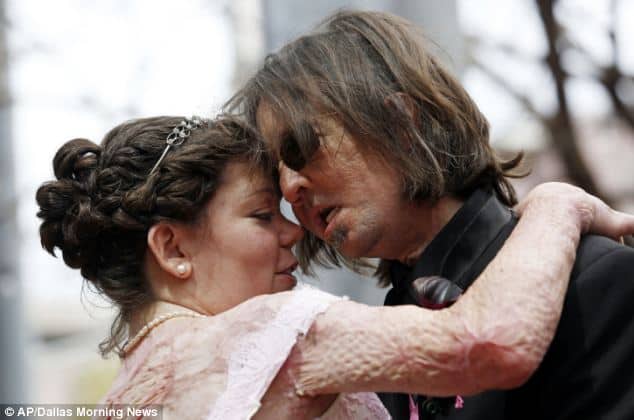You’ve heard of heart, liver and heart transplants…but face transplant surgery? Here’s how three people are starting over after facing the unthinkable: getting a new face from an organ donor.
The first story of starting over after face transplant surgery is Dallas Wiens and Jamie Nash.
“It’s a story of hope, a story of true survivors,” says Jamie. “I mean, if we can do it, I guarantee you, anybody out there can do it – we all have a story. We’re all going through something. And I want to give everybody hope.”
Dallas Wiens’ Face Transplant Surgery
Dallas’ entire face was burned off after his head touched a high-voltage power line while painting the Ridglea Baptist Church in November, 2008. He was left blind. His entire face was burned off and he later became the first full face transplant patient in the U.S. He received a new nose, lips, skin, muscle and nerves from an anonymous donor.
Jamie almost died in a car crash in 2010. Her car erupted in flames, and she was trapped. She was severely burned on her hands, back and legs. Jamie and Dallas met at a support group for burn survivors at a hospital. Dallas was speaking to the group, and Jamie was
They married after Dallas’ face transplant surgery. You’ll never believe where they got married: at the same church where Dallas’ face was burned. Dallas and Jamie believe it is providence that they are together – they are soulmates. They never would have met if each hadn’t been burned so badly.

Dallas Wiens and Jamie Nash, at their wedding
Confidence despite the facial burns. The couple met when Dallas spoke to a group of burn patients at Parkland Hospital. Jamie was intrigued as soon as he walked in, because of his confidence and self-acceptance. Her body is scarred because of the car fire, but her face is intact. “I’m looking at my scars thinking, ‘I don’t know if I could deal with something happening my face,’” she told People magazine. I think we all feel the same way – can you imagine your face being burned off and undergoing face transplant surgery? Wow.
Source of Dallas and Jamie’s story: Newlyweds who both suffered horrific burns say they wouldn’t change a thing because their injuries brought them together on the DailyMail Online UK.
Carmen Tarleton’s Face Transplant Surgery
The psychological impact of a face transplant is very challenging. Unlike a kidney, liver, or heart transplants, everyone can see a donated face. This presents unique hurdles for recipients and their loved ones.
Six years ago, Carmen Tarleton’s estranged husband broke into her house one night, beat her with a baseball bat and soaked her with industrial lye that he squirted from a dish-soap bottle. The attack nearly blinded her, and burned her beyond recognition. She lost her eyelids, upper lip and left ear. What remained of her face and much of her body was a knobby patchwork of scar tissue and skin grafts, painful to look at and far more painful to live with.
It took a long time to get on the face transplant donor list. After several visits to Brigham’s for physical and psychological screening to determine if she was a good candidate, Carmen got on the donor list. “It was like a big surprise, a big gift,” she says. “I’d already accepted my disfigurement, fine. But I accepted it believing there wasn’t an alternative.”
Does Carmen’s new face look like her donor? After the face transplant surgery, Carmen doesn’t look like her donor (56 year old Cheryl Denelli Righter of North Adams, Mass., who died after a stroke). Doctors say this is typical for face transplant recipients, partly because their bone structures are different from their donors. Carmen now has a cleft in her chin, which neither Cheryl’s nor Carmen’s old face had.
Carmen has undergone nearly 60 operations, and a great deal of post-operative pain. Her immune system rejected her new face for three weeks after the face transplant surgery, but medications have helped her body accept the new tissue. She is learning how to move her new lips, and is blogging and writing a book about her experience.
If you were faced with something as devastating as face transplant surgery,
who or what would you lean on to survive?
After her face transplant surgery, Carmen wrote on her blog:
“I know now after going to one of the most negative places possible, while still remaining alive, that I can now go to my heaven on earth. There is nothing to lose, only joy to gain and it only comes from within me. I have complete control to make choices that lead me to happiness or not. When you know this and take full responsibility for being here, it gives you an incredible amount of confidence and security…Use negative events to your advantage, to propel you to the next place in your life. Evolving and expanding with joy and happiness is the essence of who we are.” – from Carmen’s blog Overcome: Burned, Blinded, and Blessed.
Carmen’s face transplant was performed at Brigham and Women’s Hospital in Boston, in February 2013. The first face transplant surgery was done only eight years ago, in France. There have been about two dozen full or partial face transplant surgeries completed worldwide – and five have been at Brigham and Women’s.
Source of Carmen’s story: For Victim of Ghastly Crime, a New Face, a New Beginning from the New York Times.
Xu’s Face Transplant Surgery in China
A face transplant using facial parts from one’s own body. Xu Jianmei is a 17-year-old teenager in China. She was severely disfigured in a fire when she was five, and recently received a face transplant. In the fire, she lost her chin, eyelids and most of her right ear, but her family couldn’t afford to pay for any type of medical procedure at the time. Last year, doctors proposed growing a new face on her chest, using skin grafted from her leg. Parts of her new face were grown on her chest.
“First, we took a piece of blood vessel fascia from her thigh and implanted it in her chest,” said face transplant surgeon Jiang Chenghong. “Then we inserted a skin expander beneath the part of skin where the blood vessel fascia was planted, so that the part could expand and produce enough skin for her new face.” The tissue on Xu’s chest was kept alive until it was transplanted to her face. Doctors expect the wounds to heal in a few weeks.
Source of Xu’s story: Girl receives face transplant in SE China.
The First Face Transplant Surgery
According to Wikipedia, the first partial face transplant surgery on a living human was performed on Dinoire on 27 November 2005 by Professor Bernard Devauchelle in France. A triangle of face tissue, including the nose and mouth, was taken from a brain-dead female donor and grafted onto the patient. “Scientists elsewhere have performed scalp and ear transplants. However, the claim is the first for a mouth and nose transplant. Experts say the mouth and nose are the most difficult parts of the face to transplant.” ~ from Isabelle Dinoire’s Face Transplant Surgery.
Why are face transplant surgeries so rare, and so complicated? Arteries, veins, nerves and muscles from the donor face must be painstakingly connected to the recipient’s. Face transplants are complicated and difficult.
Face transplant surgeries are so BIG, and make whatever we’re dealing with small in comparison, don’t you think? I welcome your comments on starting over after face transplant surgery below.
Here’s another story here on New Beginnings about coping with serious health issues: Hypothyroidism Treatment – How Sara Survived Hashimoto’s Thyroiditis. And, here’s how Mary Ellen Ciganovich is Dealing With a Double Diagnosis of Epilepsy and MS.




